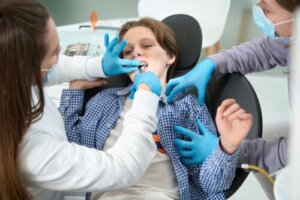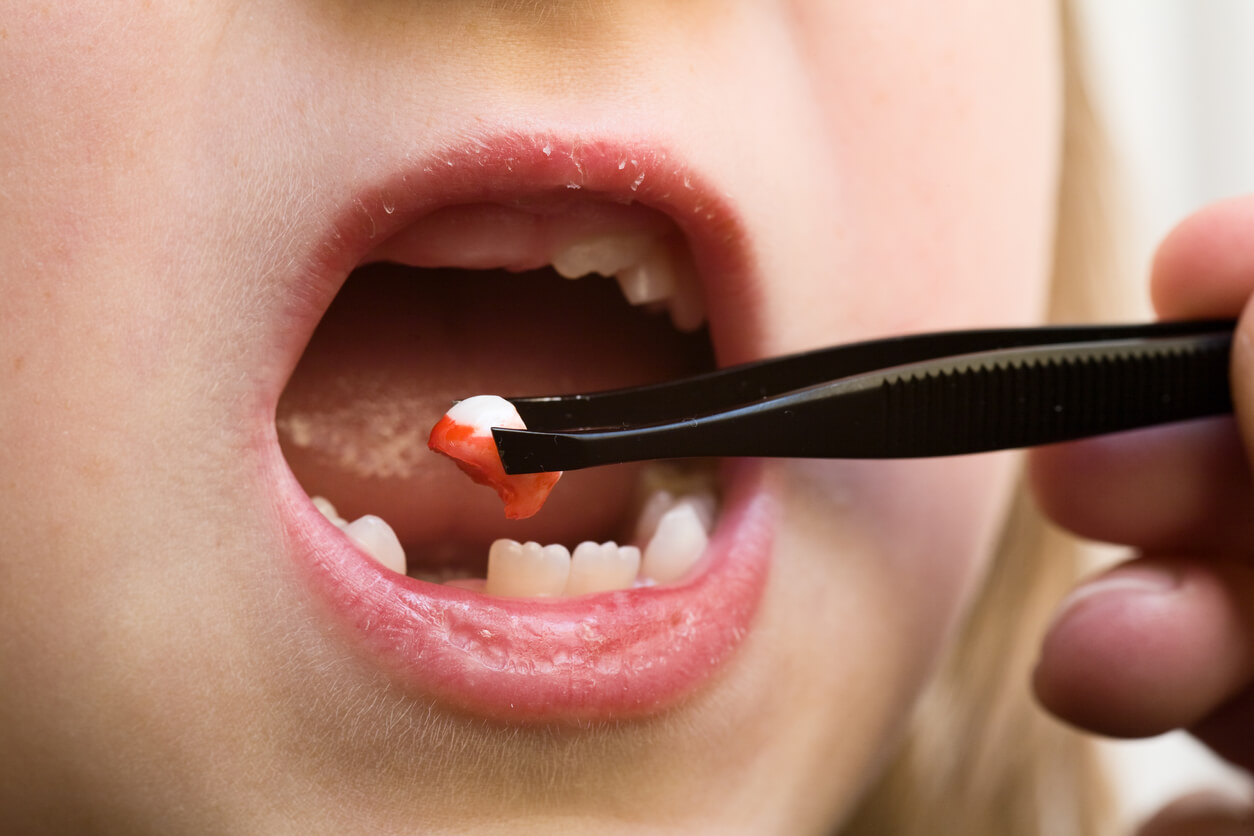Do Tooth Extractions in Children Hurt?


Written and verified by the dentist Vanesa Evangelina Buffa
When tooth extractions in children are needed, it’s common for parents to wonder if they hurt or cause discomfort. In this article, we’ll tell you about these procedures in children’s mouths and how you should accompany them. We’ll also give you some tips to help your little one recover better after surgery.
Fear of the unknown can make dental extractions a difficult and anxious situation, both for children and their parents. But you should know that, in general, these are simple procedures that you don’t need to worry about.
Reasons for extractions in children
Most of the time, it’s best to keep the teeth in the mouth rather than take them out. Tooth extractions in children are only recommended when they’re necessary and other treatments aren’t possible. This is because removing a tooth affects the harmony and esthetics of the smile, affects the functions of the mouth, and can cause the mobilization of the remaining elements.
However, there are situations in which the persistence of the tooth becomes a health risk or affects the harmony of the rest of the dentition. In these cases, dental extractions will be indicated. These are some of the situations that may lead the pediatric dentist to indicate extraction.
- Severely damaged or destroyed teeth due to cavities or trauma.
- Teeth with pain or infections that can’t be treated with endodontics.
- Infectious processes that put at risk the permanent teeth that are being formed, the other dental elements, or other structures of the mouth.
- Persistence of a baby tooth that fails to fall out on its own and affects the eruption of the permanent tooth.
- To allow the correct alignment of a definitive element.
- As part of orthodontic treatment, especially in cases of lack of space in the arch and severe crowding.
Find out if tooth extractions in children hurt
Tooth extractions in children generally don’t hurt, as the intervention is performed after numbing the area with local anesthesia. However, depending on the complexity of the procedure, the child may feel some sensations of discomfort.
A local anesthetic is used to anesthetize the tooth area. This requires injecting the liquid through one or several punctures in the mouth. As with any injection, this may cause pain or discomfort for the child. When the anesthesia takes effect, the tooth to be removed and the surrounding tissues stop feeling. Therefore, with the area numb, extractions don’t hurt.
In cases of very fearful children, children with dental anxiety, or those cases that require more complex surgical procedures, some types of sedation may be used. Also, depending on the particularities of the case, some professionals choose non-pharmacological relaxation methods that help to calm the little ones. The premise is that the extraction should be a positive experience.

Simple and complex interventions
In simple extractions, in order to remove the tooth from the mouth, the dentist separates the tooth from the gum and then mobilizes it with specific instruments. When the tooth is completely detached from the supporting tissues, it’s removed with forceps.
In more complex procedures, it’s necessary to cut the gum, remove bone tissue, and even separate the tooth into several fragments. Rotary instruments are usually used for this purpose.
Care to ensure that tooth extractions in children don’t hurt
Although dental extractions in children don’t hurt, some discomfort may occur once the medication wears off. In general, recovery is quick and easy, but if complications arise, there will be discomfort and pain.
- Take care of the blood clot that forms in the cavity left by the missing tooth after extraction. This structure is what allows the formation of new tissue and wound healing. At the end of the extraction, the pediatric dentist places gauze in the socket that the child should bite to stop the bleeding and promote the formation of the clot. The gauze should be kept in the mouth for about 15 minutes and then removed and discarded.
- Avoiding rinsing the mouth in the first 24 hours or drinking liquids with straws is another way to keep the clot intact. In addition, the child should be reminded not to touch the wound with the hands or tongue.
- Soft and fresh foods should be preferred and hard and crunchy textures should be avoided. Yogurts, ice cream, compotes, purees, and cold soups are excellent choices.
- Apply an ice pack intermittently to relieve swelling in the area.
- Don’t pass the toothbrush over the extraction site to avoid bleeding. The brushing of the rest of the elements should continue, but it has to be done very carefully and gently.
- Avoid sports and physical activity for a few days, as the child should rest after the extraction.
- Follow all the dentist’s instructions and return to the scheduled controls to achieve a good recovery. If stitches were made, the child will need to go to the dentist’s office in 7 days to have them removed.

When to contact the pediatric dentist?
The recovery of oral tissues after an extraction is usually fast and doesn’t involve major problems. However, some complications may arise that will require assistance from the professional. These are some signs to watch out for:
- Bleeding: Although the presence of blood after surgery is to be expected, you should contact your dentist if the bleeding is abundant and doesn’t stop.
- Fever: The presence of a fever may indicate an infection.
- Numbness: If your child has a lack of sensation in the lips, chin, or another part of the face, you should look for the origin.
- Pain: If the discomfort in the extraction area gets worse and worse, you’ll need to ask for help.
- Swelling: Persistent swelling of the gums or face requires the intervention of a pediatric dentist.
Find a dentist you trust
Thinking that tooth extractions in children hurt or cause discomfort may lead parents to avoid this intervention. Looking for a trusted pediatric dentist is essential in order to calm anxiety in little ones and in the adults who accompany them. You should know that extractions are only performed when necessary. In addition, the professionals have sufficient resources to make the experience pleasant.
Take the time to find a dentist who’ll give your child the security they need. Patience, communication, and familiarity will help make tooth extractions hassle-free.
When tooth extractions in children are needed, it’s common for parents to wonder if they hurt or cause discomfort. In this article, we’ll tell you about these procedures in children’s mouths and how you should accompany them. We’ll also give you some tips to help your little one recover better after surgery.
Fear of the unknown can make dental extractions a difficult and anxious situation, both for children and their parents. But you should know that, in general, these are simple procedures that you don’t need to worry about.
Reasons for extractions in children
Most of the time, it’s best to keep the teeth in the mouth rather than take them out. Tooth extractions in children are only recommended when they’re necessary and other treatments aren’t possible. This is because removing a tooth affects the harmony and esthetics of the smile, affects the functions of the mouth, and can cause the mobilization of the remaining elements.
However, there are situations in which the persistence of the tooth becomes a health risk or affects the harmony of the rest of the dentition. In these cases, dental extractions will be indicated. These are some of the situations that may lead the pediatric dentist to indicate extraction.
- Severely damaged or destroyed teeth due to cavities or trauma.
- Teeth with pain or infections that can’t be treated with endodontics.
- Infectious processes that put at risk the permanent teeth that are being formed, the other dental elements, or other structures of the mouth.
- Persistence of a baby tooth that fails to fall out on its own and affects the eruption of the permanent tooth.
- To allow the correct alignment of a definitive element.
- As part of orthodontic treatment, especially in cases of lack of space in the arch and severe crowding.
Find out if tooth extractions in children hurt
Tooth extractions in children generally don’t hurt, as the intervention is performed after numbing the area with local anesthesia. However, depending on the complexity of the procedure, the child may feel some sensations of discomfort.
A local anesthetic is used to anesthetize the tooth area. This requires injecting the liquid through one or several punctures in the mouth. As with any injection, this may cause pain or discomfort for the child. When the anesthesia takes effect, the tooth to be removed and the surrounding tissues stop feeling. Therefore, with the area numb, extractions don’t hurt.
In cases of very fearful children, children with dental anxiety, or those cases that require more complex surgical procedures, some types of sedation may be used. Also, depending on the particularities of the case, some professionals choose non-pharmacological relaxation methods that help to calm the little ones. The premise is that the extraction should be a positive experience.

Simple and complex interventions
In simple extractions, in order to remove the tooth from the mouth, the dentist separates the tooth from the gum and then mobilizes it with specific instruments. When the tooth is completely detached from the supporting tissues, it’s removed with forceps.
In more complex procedures, it’s necessary to cut the gum, remove bone tissue, and even separate the tooth into several fragments. Rotary instruments are usually used for this purpose.
Care to ensure that tooth extractions in children don’t hurt
Although dental extractions in children don’t hurt, some discomfort may occur once the medication wears off. In general, recovery is quick and easy, but if complications arise, there will be discomfort and pain.
- Take care of the blood clot that forms in the cavity left by the missing tooth after extraction. This structure is what allows the formation of new tissue and wound healing. At the end of the extraction, the pediatric dentist places gauze in the socket that the child should bite to stop the bleeding and promote the formation of the clot. The gauze should be kept in the mouth for about 15 minutes and then removed and discarded.
- Avoiding rinsing the mouth in the first 24 hours or drinking liquids with straws is another way to keep the clot intact. In addition, the child should be reminded not to touch the wound with the hands or tongue.
- Soft and fresh foods should be preferred and hard and crunchy textures should be avoided. Yogurts, ice cream, compotes, purees, and cold soups are excellent choices.
- Apply an ice pack intermittently to relieve swelling in the area.
- Don’t pass the toothbrush over the extraction site to avoid bleeding. The brushing of the rest of the elements should continue, but it has to be done very carefully and gently.
- Avoid sports and physical activity for a few days, as the child should rest after the extraction.
- Follow all the dentist’s instructions and return to the scheduled controls to achieve a good recovery. If stitches were made, the child will need to go to the dentist’s office in 7 days to have them removed.

When to contact the pediatric dentist?
The recovery of oral tissues after an extraction is usually fast and doesn’t involve major problems. However, some complications may arise that will require assistance from the professional. These are some signs to watch out for:
- Bleeding: Although the presence of blood after surgery is to be expected, you should contact your dentist if the bleeding is abundant and doesn’t stop.
- Fever: The presence of a fever may indicate an infection.
- Numbness: If your child has a lack of sensation in the lips, chin, or another part of the face, you should look for the origin.
- Pain: If the discomfort in the extraction area gets worse and worse, you’ll need to ask for help.
- Swelling: Persistent swelling of the gums or face requires the intervention of a pediatric dentist.
Find a dentist you trust
Thinking that tooth extractions in children hurt or cause discomfort may lead parents to avoid this intervention. Looking for a trusted pediatric dentist is essential in order to calm anxiety in little ones and in the adults who accompany them. You should know that extractions are only performed when necessary. In addition, the professionals have sufficient resources to make the experience pleasant.
Take the time to find a dentist who’ll give your child the security they need. Patience, communication, and familiarity will help make tooth extractions hassle-free.
All cited sources were thoroughly reviewed by our team to ensure their quality, reliability, currency, and validity. The bibliography of this article was considered reliable and of academic or scientific accuracy.
- Acosta, E. O. (2019). Experiencias relacionadas con la pérdida dental durante la infancia y la juventud. Revista Estomatología, 27(1), 18-30.
- Arslan, I., Aydinoglu, S., & Karan, N. B. (2020). Can lavender oil inhalation help to overcome dental anxiety and pain in children? A randomized clinical trial. European Journal of Pediatrics, 179, 985-992.
- Baillargeau, C., Lopez‐Cazaux, S., Charles, H., Ordureau, A., Dajean‐Trutaud, S., Prud’homme, T., … & Renard, E. (2020). Post‐operative discomforts in children after extraction of primary teeth. Clinical and experimental dental research, 6(6), 650-658.
- Cazas Campos, L. V. Abordaje terapéutico de exodoncia en niños minimizando miedo y ansiedad (Doctoral dissertation).
- García Arellano, M. Á. (2022). Manejo clínico para la extracción de piezas temporarias en la consulta odontológica (Bachelor’s thesis, Universidad de Guayaquil. Facultad Piloto de Odontología).
- Gutiérrez-Solís, A. L., & Gómez-De Regil, L. Uso de la hipnosis anestésica en cirugías dentales: Una revisión breve.
- Herrera, M. D. S., Medina-Solís, C. E., Robles-Bermeo, N. L., Minaya-Sánchez, M., Alonso-Sánchez, C. C., Lara-Carrillo, E., … & Bayardo-González, R. A. (2017). Consulta por extracción dental en niños nicaragüenses: una aproximación a las necesidades de atención bucal. Pediatría (Asunción), 44(3), 239-244.
- Munayco-Pantoja, E. R., Pereyra-Zaldívar, H., & Cadillo-Ibarra, M. M. (2021). Consecuencias Clínicas de las Lesiones Cariosas no Tratadas y su Impacto en la Calidad de Vida de Preescolares Peruanos. International journal of odontostomatology, 15(1), 256-262.
- Shetty, V., Suresh, L. R., & Hegde, A. M. (2019). Effect of virtual reality distraction on pain and anxiety during dental treatment in 5 to 8 year old children. Journal of Clinical Pediatric Dentistry, 43(2), 97-102.
- Sotomayor Acosta, M. N. (2022). Control de la ansiedad en la consulta odontológica en niños y adolescentes mediante estrategias alternativas, revisión bibliográfica.
This text is provided for informational purposes only and does not replace consultation with a professional. If in doubt, consult your specialist.








